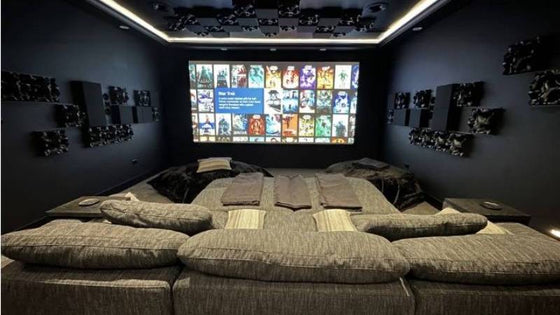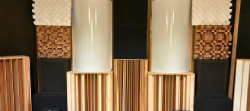Creating a system you love shouldn't be difficult. The Acoustic Frontiers blog is here to help.

This blog article is the third in a series on speaker directivity and off axis response. Previous articles in the series established the psychoacoustic as well as subjective importance of speaker off axis response and looked at different ways to measure speaker directivity. Today we will look at the directivity characteristics of forward firing cone / dome speakers. This category of speaker design represents the vast majority of speakers manufactured today and what most people own. These speakers are comprised of two or more forward facing drivers with cones for the reproduction of low to mid frequencies and domes for the high frequencies. Variations on this approach such as dome midranges, ring radiator tweeters and the like all have similar issues. Future articles will examine other speaker designs including co-axial, dipole, dipolar hybrids and horns.
This type of speaker typically has an off axis response that deviates from the on axis response. The classic issue is mismatch of drive unit directivity at the crossover point between the midrange and tweeter. Typically what you will see is that the midrange driver starts to beam (i.e. the directivity narrows) as the frequency is increased. Yet when the tweeter is brought in its response is very wide. On axis things look good but off axis analysis reveals a lack of energy due to midrange beaming. These issues are most pronounced in speakers using 5″+ midrange drivers with 1″ tweeters.
A couple of examples are shown below. The left hand graph, from a StereoPhile review of the Vienna Acoustics Mahler is particularly bad. Even at relatively shallow off axis angles such as 30 degrees there is an obvious ridge at 3kHz. The right hand graph, from a StereoPhile review of the B&W Nautilus 805, is well behaved with a quite consistent off axis response to angles of around 30 degrees, after which the lack of off axis energy from the midrange becomes visible in the overall shape of the graph.
From a room acoustic treatment perspective speakers with off axis performance like this force the designer’s hand. The speaker on the left, the Vienna Acoustics, will sound better with the lateral reflections fully absorbed in all but the largest rooms where the speakers and listener are far from boundaries and hence reflections are low in level relative to the direct sound. In most rooms leaving the lateral early reflection points untreated would create an obviously colored sound, particularly in the region from 1-4kHz due to the significant variation in the off axis frequency response. We have more flexibility with the speaker on the right (the B&W) but leaving the lateral reflection points untreated at angles over 30 degrees would still lead to timbral coloration in the 1-4kHz range.

More advanced cone / dome speakers nearly always use a waveguide on the tweeter in order to better match the directivity to the midrange driver at the crossover point.
Below are a couple of examples of waveguided tweeters, the left from Revel’s M105 and the right from YG’s Carmel. In both cases you can clearly see the shallow depression around the tweeter. This depression shapes the dispersion of energy from the tweeter essentially making it radiate like that of a driver with a larger diameter in the lower frequencies.

Now let’s take a look at some measurements of waveguided speakers to see how this approach works in terms of it’s ability to shape the off axis response.
Below is the YG Anat, from this StereoPhile review. Your guess is as good as mine as to where the crossover point is between the midrange and the tweeter! This is a very well designed speaker with no obvious off axis issues due to mismatched midrange / tweeter directivities. The waveguide has clearly done it’s job!
This type of speaker gives a skilled acoustic designer huge flexibility in how they treat the room. The room’s early and late reflected contributions to the measured and perceived sound can be shaped to the client’s subjective preference. Early lateral reflection points can be left reflective for maximum soundstage width and envelopment or can be absorbed for more precise imaging. In the right room, where the listener is relatively far from boundaries, diffusion can be used to break up and redirect reflections.

All speakers with vertically arranged tweeter / midrange drivers will have some nulls in their vertical off axis response. These nulls are caused by phase cancellation due to differences in the length of the sound path between the two drivers and the measurement location. There is a mathematical relationship between the path length difference and the cancellation frequency. A 1″ difference, for example, will cause a cancellation null at 6780Hz and a 2″ difference 3390Hz. Even in a speaker as well engineered as the YG Anat, which has exceptional lateral off axis response, looks messy in the vertical domain. The graph below only goes out to 45 degrees off axis, compared to 90 degrees for the lateral off axis graph above, yet clear nulls exist in the off axis response at angles beyond 25 degrees.

For the acoustic designer these off axis nulls, present in all forward firing vertically arranged cone / dome speakers, represent reflections with a distorted spectral balance that can contaminate the potentially very well behaved sound arriving from early lateral reflections. The two boundaries which must be considered are the floor and ceiling.
The floor is always a challenge as rarely is it possible to design in a 3″+ fiberglass absorber into the floor for consistent absorption down to below the room’s transition frequency (although it has been done in some home theaters, with a heavy grate over the top and then carpet over that!). The solution generally revolves around using a thick carpet, typically made of wool or natural fibers, with a thick jute or woven fiber rug underneath. This approach provides relatively consistent absorption down to 500Hz or so.
There are more options with the ceiling. In rooms with high ceilings the reflection is at a lower level relative to the direct sound due to the spherical way in which sound expands and loses energy at 6dB per doubling of distance. With high ceilings any treatment we use at early reflection points is also further away from the listener and there are therefore less issues with using engineered diffusers which are generally required to be no less than 3x the wavelength of the lowest diffused frequency (in order that the listener is in the diffusers farfield). This allows us to use either absorbers or diffusors, or some combination of the two. In rooms with lower ceilings absorption at ceiling reflection points is generally the recommended option, though it is possible to use geometric diffusors which do not have the same minimum distance as their engineered brethren.
Hopefully this article has been educational, please leave your thoughts via the add a comment function below! In future articles we will look at the off axis response characteristics of other speaker types such as single driver / coaxial, panel dipoles and horns.
This media room was intentionally designed to feel like part of the home—not a separate, tech-heavy space. Through careful acoustic planning, equipment integration, and final calibration, we achieved a room that is both beautiful to live in and immersive to experience.
"No other subwoofer system I’ve owned even comes close to what this room delivers. Reaching out to Acoustic Frontiers was one of the best decisions I’ve made—I highly recommend working with them if you want to get the most out of your theater."

Nyal Mellor, Founder, Acoustic Frontiers



Nyal Mellor
Author